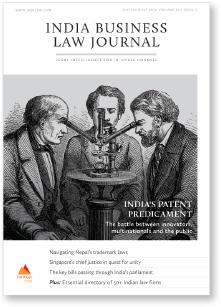Pushed to the wall by a scarcity of resources, ingenious people up and down India have long slapped together odd bits and pieces to create and extend the life of essentials. Ultra-low-cost solar lamps, agricultural pumps that power tractors and mobile phones that do a lot more than their manufacturers ever imagined are some of the many jugaad-inspired marvels that add to the many sights and sounds of “Incredible India”.

Focusing on an India that is working to improve its image as a patent-friendly jurisdiction, this issue’s Cover story asks who will triumph in the tussle between innovators, multinationals and the general public. Indian innovators and others filed only around a quarter of all patent applications filed in India over the past three years – the vast majority were filed by international parties. This points to the country’s growing prominence among international IP owners, many of whom are critical of what they see as inadequate protection for their IP assets.
According to Ashwin Julka, the managing partner of Remfry & Sagar, while India’s legal framework may be adequate and sufficient, “clear guidelines and proper, uniform implementation … in the processing of patent applications is needed.” Also absent is a general uniformity across India’s IP offices. In the meanwhile, asset owners should also refrain from blindly trying to implement strategies and techniques that they use elsewhere. According to Adarsh Ramanujan, a director of the Geneva office of Lakshmikumaran & Sridharan, pursuing Indian applications “requires some special attention and careful thinking in many instances”.
In Marks in trouble we turn the spotlight onto neighbouring Nepal, which has a first-to-file IP regime that is causing Indian and international trademark owners many a sleepless night. This is a jurisdiction where prior registration is given more weight than cross-border international reputation, thus helping local registrants keep foreign brand owners at bay. The only way forward may be through the World Trade Organization, which could persuade Nepal to honour its commitments to the organization and under various IP agreements.
This issue’s Vantage point continues on the subject of protecting brands. In it Idil Yasa, branding ban vice-president at Japan Tobacco International, argues that an honest debate about what constitutes effective and proportionate regulation is needed. Yasa says that the branding ban for tobacco products introduced in Australia, which she believes completely misunderstood the role and value of brands and trademarks, has dramatically impacted market dynamics in that country without accelerating a decline in smoking levels. Yasa says it is time for everyone who values brands, trademarks and good governance to voice their concerns and challenge proposals for such bans.
A call for convergence is also behind the creation of the Asian Business Law Institute in Singapore. In Unity in Asia Singapore’s Chief Justice Sundaresh Menon, a champion of business law convergence in the region, talks about the possibilities that the institution represents. “The case for the convergence of business laws in Asia is pressing because we all begin from quite different legal starting points,” says Menon, who emphasizes that “we live in a time where there is as much to gain from deeper interconnectivity as there is to lose from detached insularity”. A lofty vision that appears set to fly.
In Laying down laws we analyse key bills before the Indian parliament that will impact domestic and international businesses. Vital among them is a constitutional amendment bill to pave the way for a goods and services tax (GST) that is to subsume several indirect taxes into a unified value-added tax system. Experts have argued that adopting the tax could increase India’s GDP by at least 0.5%.
It is against this backdrop of sweeping initiatives such as a unified GST that India Business Law Journal publishes the ninth annual edition of its India Business Law Directory, which we believe is the most extensive directory of Indian law firms available. The directory is accompanied by an editorial analysis of the state of play in India’s legal market (A view from the inside). With the approaching entry of foreign law firms into India and despite the health of the market being somewhat precarious, sentiment continues to be upbeat. Lawyers recognize the significant potential for growth, given the slow but steady rise of corporate India and the increasing number of laws and regulations that companies of all sizes need to keep up with. So, even as lawyers regularly speak of a price war in the market, there is talk of expansion and growth. The challenge however will be “to be ahead of the curve” as Rabindra Jhunjhunwala, a partner at Khaitan & Co, says.
Chances are India’s ingenious and innovative lawyers will be up for it and more.



























